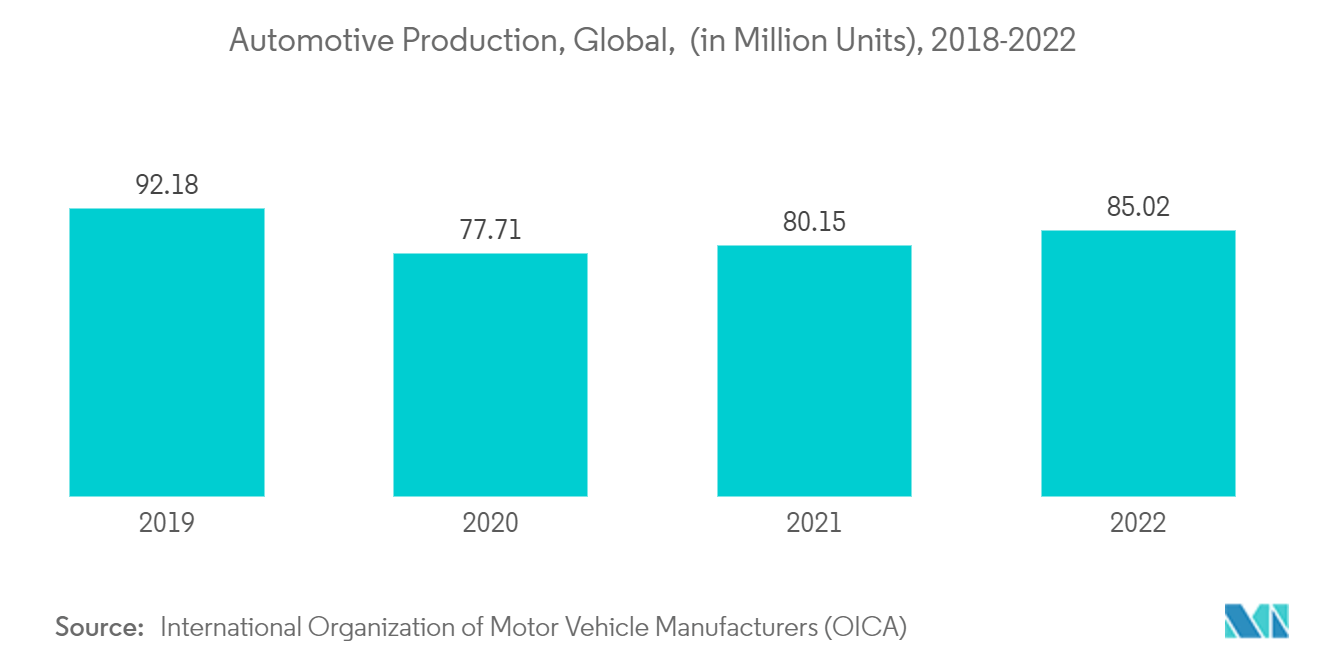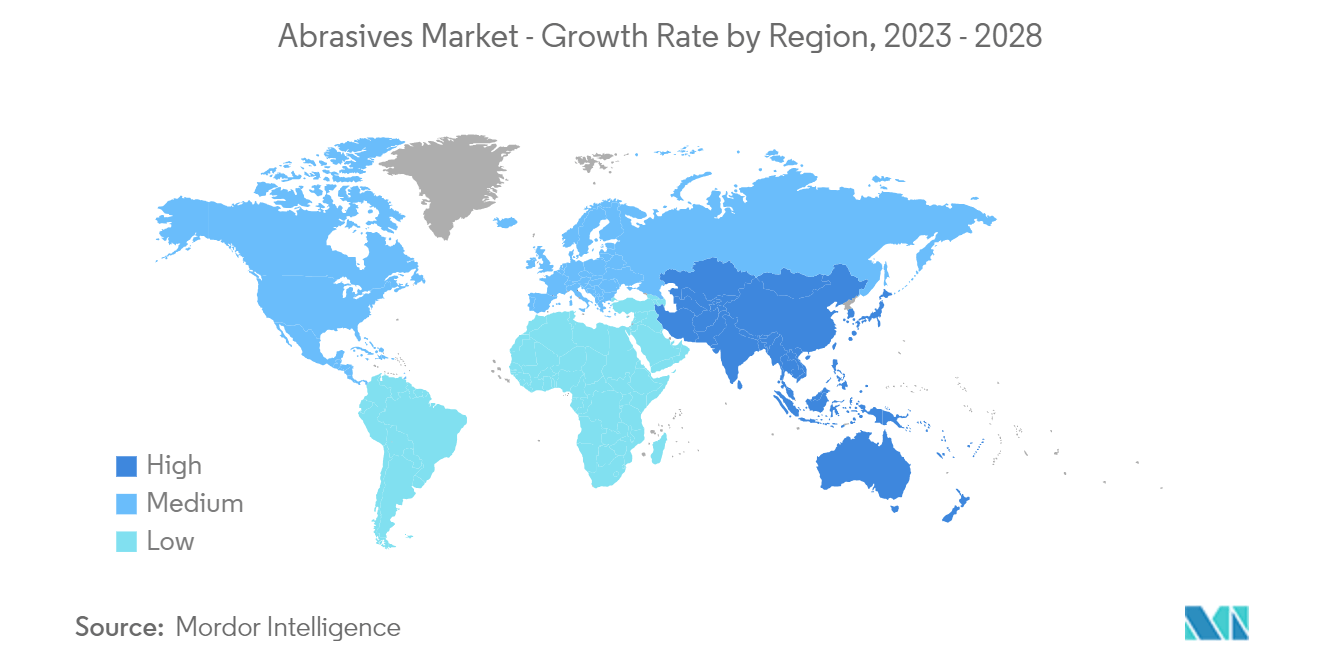Market Trends of Abrasives Industry
Increasing Use in the Aerospace and Automotive Sectors
- The automotive sector is one of the major users of abrasives. As the demand for light and fuel-efficient automobiles has increased, such high-performance automobiles are being developed using bonded abrasive grinding tools for different applications.
- Abrasive grinding operations are used extensively in the automotive industry to manufacture several driveline, suspension, body, and chassis components.
- Moreover, abrasive products are mainly used in the aerospace sector for the cutting and polishing of various castings in the manufacture of steam turbines, the strong grinding of the roots of turbine blades, and the polishing of the blade airfoil.
- Bonded abrasives are widely used in the aerospace industry. Abrasives in the aerospace industry are required for removing discoloration, removing rust and paint, deburring, fine sanding, finishing, blending, lacquer retouching, scuffing, surface treatment, flatting, polishing, weld preparation, and structuring.
- According to the Organization Internationale des Constructeurs d’Automobiles (OICA), around 85.01 million vehicles were produced in 2022, witnessing a growth rate of 5.99% compared to 80.205 million vehicles in 2021, thereby indicating an increased demand for acrylonitrile from the automotive industry. In 2022, around 60 million passenger cars were manufactured, which was nearly 7.35% compared to 2021.
- Additionally, the rising production of electric vehicles is likely to enhance the market demand for the Electric Vehicle segment. According to the EV Volumes, electric vehicle (EVs) sales reached 10.522 million units in 2022, registering a growth rate of 55% compared to 2021. As per the World Economic Forum (WEF), nearly 4.3 million new battery-powered EVs (BEVs) and plug-in hybrid electric vehicles (PHEVs) were sold in the first half of 2022. In addition, BEV sales grew by 75% on the year and PHEVs by 37%.
- Furthermore, the aerospace industry is experiencing stagnant growth owing to the strengthening of passenger travel demand. The backlog of new aircraft orders and the constant resurgence of business aircraft might add to the growth of the aerospace industry.
- According to the International Air Transport Association (IATA), the revenue for commercial airlines was valued at USD 727 billion in 2022, registering a growth rate of 43.6% Y-o-Y. Furthermore, the payment is expected to reach USD 779 billion by the end of 2023. Such factors are likely to increase the demand for flexible hoses as aerospace parts manufacturing is likely to grow.
- Moreover, according to the Boeing Commercial Outlook 2023-2042, the demand for new commercial jets by 2042 is expected to reach 42,595 units, valued at USD 8 trillion. The fleet is expected to double to 48,600 aircraft by 2042, expanding by 3.5% annually. Airlines are expected to replace about half of the fleet with new, more fuel-efficient models.
- Therefore, owing to the above factors, the growing automotive and aerospace industry will likely increase the demand for abrasives in the coming years.

The Asia-Pacific Region is Expected to Dominate the Market
- The Asia-Pacific region is expected to dominate the abrasives market in the future. The rising construction, automotive, aerospace, and electronics industries are contributing to the massive demand in the market.
- China's growth is fueled mainly by rapid expansion in the residential and commercial building sectors and the country's expanding economy. China is encouraging and enduring a continuous urbanization process, with a projected rate of 70% by 2030. As a result, increased building activity in nations like China is projected to fuel the region's adhesive industry. All such factors tend to increase the demand for abrasives across the region.
- Furthermore, South Korean builders' overseas building orders surpassed USD 30 billion for the third consecutive year in 2022, owing to strong demand from Asia, North America, and the Pacific Ocean regions.
- In South Korea, the government has outlined its plan to execute large-scale redevelopment projects to supply 830,000 housing units in Seoul and other cities by 2025. From the planned construction, Seoul will get 323,000 new houses, and 293,000 will be built near Gyeonggi Province and Incheon. Major cities like Busan, Daegu, and Daejeon will also benefit with 220,000 new houses in 4 years.
- Moreover, the Indian electronics industry is one of the fastest-growing industries globally. The domestic electronics manufacturing sector is expanding at a steady rate, owing to favorable government policies, such as 100% foreign direct investment (FDI), no requirement for industrial licenses, and the technological transformation from manual to automatic production processes.
- According to the India Brand Equity Foundation (IBEF), the Indian electronics manufacturing industry is expected to reach USD 520 billion by 2025. Electrical and electronics production in India is expected to increase rapidly due to government initiatives with policies, such as Make in India, National Policy of Electronics, Net Zero Imports in Electronics, and Zero Defect Zero Effect, which offer a commitment to growth in domestic manufacturing, lowering import dependence, energizing exports, and manufacturing, like the “Make in India” program to make the country self-reliant.
- Moreover, in the aerospace sector, according to the India Brand Equity Foundation (IBEF), the country's aviation industry is expected to witness INR 35,000 crore (~USD 4.99 billion) investment in the next four years.
- Hence, owing to the factor above, the Asia-Pacific region is expected to dominate the abrasives market during the forecast period.


